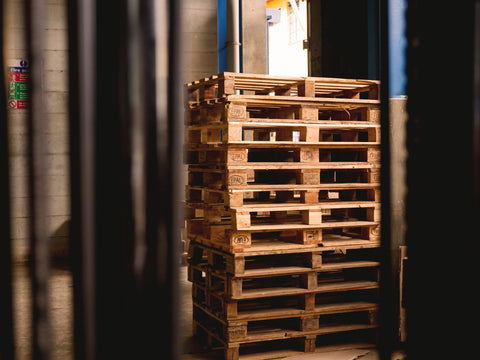wooden pallets

Stacked wooden pallets
Wooden pallets play an important role in the transport of goods and are particularly widespread. Depending on the type of products to be stored or transported, different types of wooden pallets with their own specific properties are used.
Characteristics
Wooden pallets are transport vehicles made from hard or soft types of wood in the standard size 80 x 120 cm. Many other sizes are also common. The particularly common wooden pallets can be manufactured with little effort and at low cost and have advantages for transport due to their relatively low weight. They can be used in practically all storage systems.
Spruce is typically used for transport pallets because this wood dries quickly. Beech takes a little longer to dry. To remove moisture from fresh wood, manufacturers carry out a heat treatment. This reduces both weight and mold growth, while also increasing the strength of the material.
types
The following five models are essential for the production of wooden pallets. Most wooden pallets used in practice are one of these types:
type 1
Type 1 is the most commonly used model . It can be used in practically all storage systems, including automated warehouses. It is crucial that the runners rest vertically on the longitudinal beams of the shelves, the roller paths or the guide rails to ensure the necessary stability. It can be handled with any type of forklift and pallet truck .
In Europe, there are standardized wooden pallets of this type, called Euro pallets, which always have the same properties. Companies can adapt to this optimally.
type 2
Type 2 wooden pallets are designed for storage in conventional racking or compact racking . They are also compatible with push-back racking and pallet shuttles. This type is less suitable for dynamic systems such as racking with storage and retrieval machines, and use with automatic roller conveyors is not possible. The pallets cannot be handled with forklifts.
types 3 and 4
Pallets of this type are suitable for conventional and compact racking as well as push-back racking . They can also be used with the Pallet Shuttle, but cannot be used in dynamic racking or in push-back systems with rollers.
Type 5A and 5B
The type 5 pallets are also called half pallets because they are only half the size of standard pallets. They are typically used in the high-volume distribution sector. Their size makes it easier to distribute at points of sale, such as supermarkets. Crossbeams are required for storage on normal shelves. Only type 5A is suitable for flow racks. For all other uses in shelving systems, the half racks can be placed in pairs on standard-sized Euro pallets .
wooden pallet dimensions
Here are all available dimensions of the five different types listed in the table:
| type | lengths in mm | depths in mm |
|---|---|---|
| type 1 | 1,200mm | 800/1,000/1,200mm |
| type 2 | 1,200mm | 800/1,000/1,200mm |
| types 3 and 4 | 1,200mm | 1,000/1,200mm |
| Type 5A | 800mm | 600mm |
| Type 5B | 600mm | 800mm |
alternatives
Not all wooden pallets are standardized. While the Euro pallet establishes a standard in terms of dimensions, types of wood and nails as well as the shapes of the pallets, there are alternatives that deviate from this.
If pallets deviate from the standard, there is no guarantee that they can be used in existing shelving systems . Small deviations in dimensions and design can quickly lead to the fact that they cannot be used in an automated warehouse, for example.
The non-standardized wooden pallets, on the other hand, offer the possibility of implementing individual requirements that none of the Euro pallets cover. In addition, alternatives made of compressed wood offer cost advantages.





















